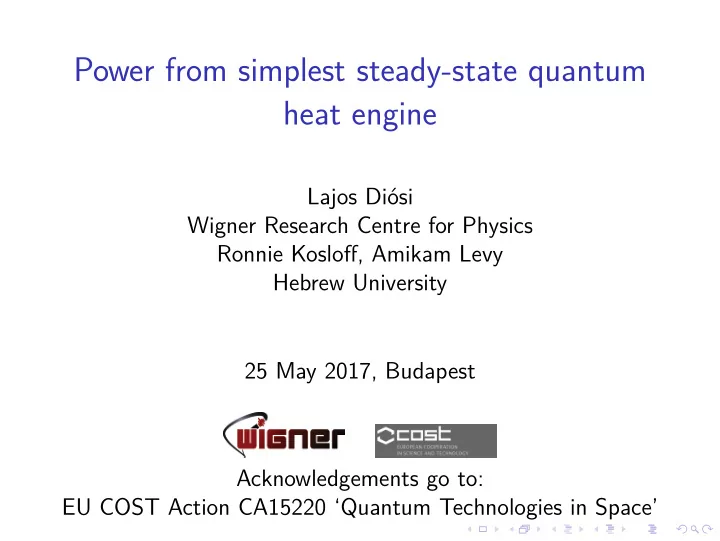

Power from simplest steady-state quantum heat engine Lajos Diósi Wigner Research Centre for Physics Ronnie Kosloff, Amikam Levy Hebrew University 25 May 2017, Budapest Acknowledgements go to: EU COST Action CA15220 ‘Quantum Technologies in Space’
1959 - ... Our quantum heat engine TLS population inversion lifts weight I. TLS population inversion lifts weight II. Which battery?
1959 - ... H.E.D. Scovil and E.O. Schulz-DuBois, Phys. Rev. Lett. 2, 262 (1959) E. Geva and R. Kosloff, J. Chem. Phys. 104, 7681 (1996) N. Linden, S. Popescu and P. Skrzypczyk, Phys. Rev. Lett. 105, 130401 (2010) L. Diósi: A short course in quantum information theory (Springer, 2011) A. Levy, L. Diósi and R. Kosloff, Phys.Rev. A93, 052119 (2016) G. Lindblad, Comm. Math. Phys. 48, 119 (1976) V. Gorini, A. Kossakowski and E. Sudarshan, J. Math. Phys. 17, 821 (1976)
Our quantum heat engine ◮ recources: hot and cold heat bath (like in classical) ◮ working medium: 3- (or 4-) level system (genuine quantum) ◮ work extraction: battery (like in classical) Operation ◮ continuous (non-cyclic) ◮ exact steady state ◮ constant power Model ◮ start with full quantum ◮ deduce effective master eq. for working medium ◮ deduce effective master eq. for battery ◮ search for battery steady state at constant power
Γ TLS population inversion lifts weight I. T c < E c e = E h − E c < 0 T − T h − E c E h T h E h T c T h e T c η mg
TLS population inversion lifts weight II. ε E h mg } − { T <0 ��� ��� ε E c ��� ��� e ��� ��� ��� ��� m { ��� ��� T h ��� ��� ��� ��� ��� ��� T ��� ��� c � ε dz � e − ε/ k B T − dt = Γ e e − 1 mg − gt Friction ¨ z = · · · − η ˙ z prevents weight’s falling: � ε dz mg − g � e − ε/ k B T − dt = Γ e e − 1 η Fluctuation at optimum friction η : � � ε � 2 t + � � e + 1 e − ε/ k B T − (∆ z ) 2 ∼ Γ e mt mg
Which battery? ◮ harmonic oscillator (Levy, D. Kosloff 2016) ◮ Steady coherent state needs active control (flywheel). ◮ Without control: fluctuations dominate deposited energy, phase of oscillation is indefinite, useless for “work”. ◮ lifted weight (Levy, D., Kosloff in preparation) ◮ Lifting needs friction(!) upon vertical motion. ◮ Steady state would need active control as well. ◮ Without active control: deposited potential energy ∝ t , moderate fluctuations ∝ √ t , useful for “work”. ◮ electric — we haven’t yet studied, but, apparently: ◮ Steady state, constant power (current) is common, ◮ even without active control. ◮ Are there hidden recources?
Recommend
More recommend